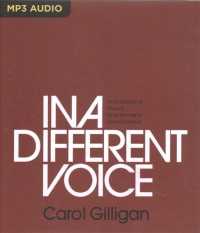- ホーム
- > 洋書
- > 英文書
- > Literary Criticism
Full Description
Much of the poetry written by W. H. Auden between 1939 and the time of his death consists of syllabic verse, or lines arranged in accordance with a predetermined syllable-count but no fixed number or distribution of stresses. This book presents a comprehensive, in-depth analysis of his many and widely varied syllabics, grouping them primarily by the formal sub-categories to which they belong (as measured by line-length, stanza-type, or some other aspect of their overall design). With this approach the book clarifies the dynamic range and technical inventiveness of Auden's syllabics. It also shows how his work of compares with that of Robert Bridges and Marianne Moore, two pioneers in the writing of English syllabic whose verse he was familiar with.
Contents
Preface. "Ur-Syllabic Verse"
Part I : Auden's Syllabic Forerunners
Chapter 1. "Any Definite Uniform Propriety": Bridges and Moore as Metrical Innovators
Chapter 2. "Pompous Old Gentleman" and "Marxist Enfant Terrible": Bridges and Auden as Strange Bedfellows
Part II: Auden's Syllabic Forms
Chapter 3. "Games and Grammar and Metres": Alcaic Quatrains
Chapter 4. "New Problems of Form": Sapphic Quatrains
Chapter 5. "A Sober Perspective": Asclepiadean Quatrains
Chapter 6. "Unmythical Mortals": Quasi-Elegiac Couplets
Chapter 7. "As Structures Go": Varieties of Rhyme
Chapter 8. "Symmetries and Asymmetries": Adaptations of Haiku and Tanka
Chapter 9. "Making a . . . Line": Related Stanzas and Couplets
Chapter 10. "Contradictory Dialect": Alliterative Lines
Chapter 11. "Some Prosodic Discipline": Miscellaneous Lines, Couplets, and Stanzas
Works Cited
Index
About the Author








